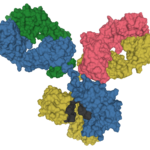
SARS-CoV-2, the virus which causes COVID-19 results in seroconversion of most patients between 7 to 14 days after diagnosis. A study of 61,000 persons in Spain showed that 5% of the population had formed antibodies against the spike and nucleoproteins and that approximately one third of infected persons were asymptomatic. The infection fatality risk has been reported to range between 0.66% (China) to 0.4% (small German town) and 0.6% (Diamond Princess Cruise ship).
The aim of this study was to assess SARS-CoV-2 seroprevalence in the population of Iceland and to assess longitudinal changes in antibody levels within the first 4 months after SARS-CoV-2 infection.
Methods
The authors screened for SARS-CoV-2 reactive serum antibodies using six different assays in two groups of quantitative polymerase chain reaction (qPCR) positive persons and six groups of persons who had not been tested with qPCR or who had been tested and received negative results.
SARS-CoV-2 specific antibodies were measured in up to 30,676 persons with assays targeting pan-immunoglobulin (pan Ig: IgM, IgG and IgA) and specific immunoglobulin against virus nucleoprotein and receptor binding domain in the S1 subunit of the spike protein.
Samples were collected from hospitalised qPCR positive persons and the authors invited all qPCR-positive persons who had recovered from infection to donate samples both shortly after recovery and 3 months after recovery. Additionally, samples from quarantined persons who had not tested qPCR-positive to evaluate infection during quarantine.
Results
- None of the samples collected in the early 2020 group were seropositive indicating the virus has not spread in Iceland widely before February 2020. The pan-Ig antibody assays demonstrated low numbers of false positives.
- 25 days after diagnosis by qPCR, more than 90% of samples from recovered persons tested positive with both pan Ig antibody assays.
- Hospitalised persons seroconverted more frequently and quickly after qPCR diagnosis than did non hospitalised persons.
- Of 1215 persons who had recovered, 1107 were seropositive (91.1%; 95% CI 89.4-92.6). Based on false positive qPCR result diagnoses, the authors determined that 91.1% represents the lower bound of sensitivity for the combined pan-Ig rests for the detection of SARS-CoV-2 antibodies among recovered persons.
- 22 persons tested negative in an early sample for both pan-Ig antibodies and 19 remained negative on a later test.
- Assessing longitudinal changes in antibody levels among recovered persons, antibody levels were higher in the last sample than in the first sample with the two pan-Ig assays.
- Antibody levels measured with both pan-Ig antibody assays increased over the first 2 months after qPCR diagnosis and remained at a plateau over the next 2 months. IgM anti- nucleoprotein antibody levels increased rapidly soon after diagnosis and then fell rapidly and were generally not detected after 2 months.
- There were 1797 qPCR positive persons in Iceland of which 1088 (61%) were in quarantine when first diagnosed.
- There were 4222 quarantined persons who had not tested qPCR positive. Of these, 97 were seropositive. Those with household exposure were 5.2 times more likely to be positive by qPCR than those with other types of exposure.
- The authors calculated that 26.6% of quarantined persons with household exposure and 5% of quarantined persons without household exposure were infected.
- Those who had symptoms during quarantine were 3.2 times more likely to be seropositive and 18.2 times more likely to test positive with qPCR than those without symptoms.
Conclusions
The authors concluded
…Antiviral antibodies against SARS-CoV-2 did not decline within 4 months after diagnosis. The risk of death from infection is estimated to be 0.3% and 44% of persons infected with SARS-COV-2 in Iceland were not diagnosed by qPCR.
Commentary
This substantial population study assessed 30,657 persons living in Iceland and evaluated the value of viral serum antibodies and its correlation with qPCR results. The findings provide insight into the interpretation of antiviral antibodies as they did not decline 4 months after infection. Other studies have demonstrated that 89% of COVID-19 infected healthcare workers carry neutralising antibodies up to 16-18 weeks post-infection however there were variable T-cell responses across the viral proteome which this study did not explore (Reynolds et al 2020). The limitations of current qPCR testing were discussed as 44% of persons infected with the virus were not diagnosed using this method in Iceland. Similar false negative rates (up to 54%) are described in other studies (Arevalo-Rodriguez et al 2020). There is more research required on the relationship between seropositivity and protection against reinfection, especially once detectable antibodies levels decline. There is rapidly emerging evidence evolving our understanding of both the disease and its management, therefore the most updated research should be used to inform clinical practice.
Links
Primary Paper
Gudbjartsson DF et al. Humoral Immune Response to SARS-CoV-2 in Iceland. N Engl J Med. 2020 Oct 29;383(18):1724-1734. doi: 10.1056/NEJMoa2026116. Epub 2020 Sep 1. PMID: 32871063; PMCID: PMC7494247.
Other references
Arevalo-Rodriguez I, et al. False-negative results of initial RT-PCR assays for COVID-19: A systematic review. PLoS One. 2020 Dec 10;15(12):e0242958. doi: 10.1371/journal.pone.0242958. PMID: 33301459; PMCID: PMC7728293.
Reynolds CJ,et al. Discordant neutralizing antibody and T cell responses in asymptomatic and mild SARS-CoV-2 infection. Sci Immunol. 2020 Dec 23;5(54):eabf3698. doi: 10.1126/sciimmunol.abf3698. PMID: 33361161.
Global Covid-19 Case fatality rates (Oxford Centre for Evidence based Medicine)
Picture Credits
By Tokenzero – Own work, CC BY-SA 4.0
